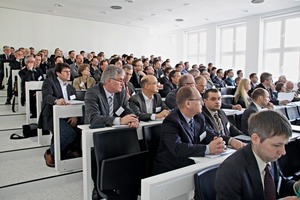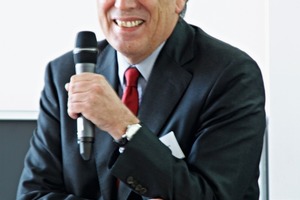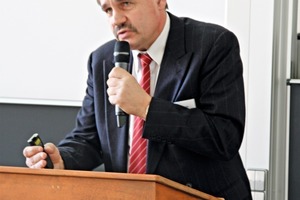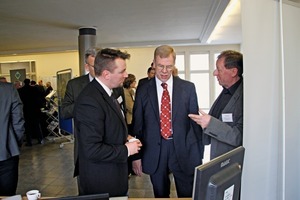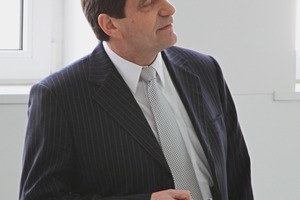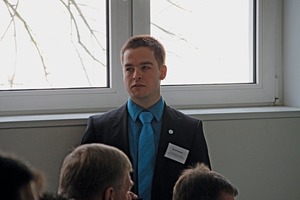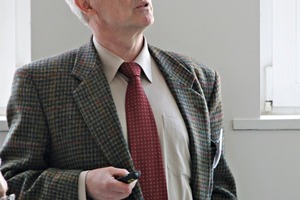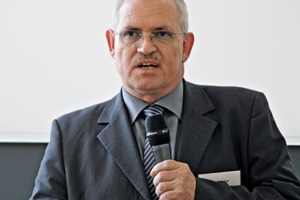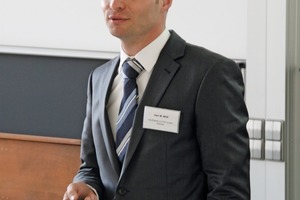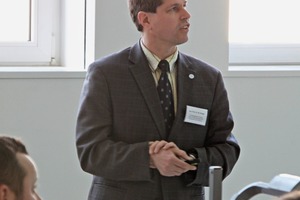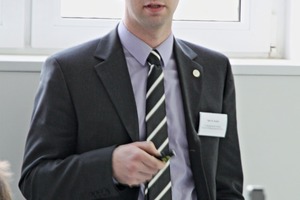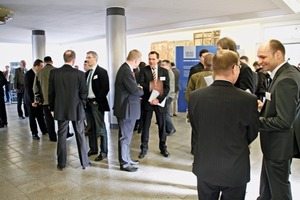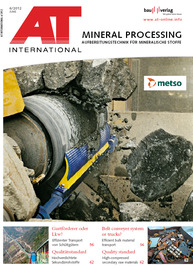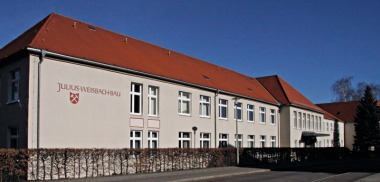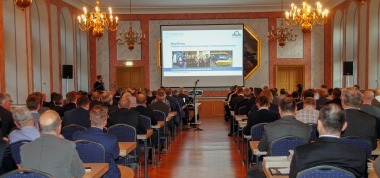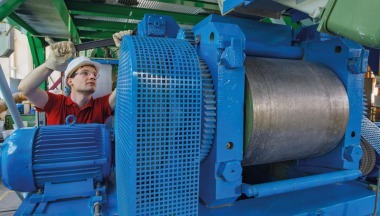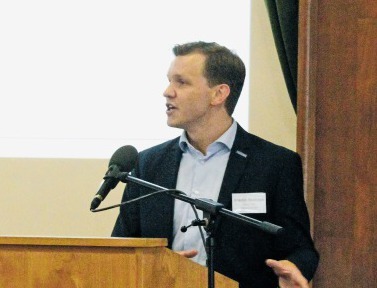Forward-looking research
Over one hundred representatives from research and industry took up the invitation of the Institute of Mineral Processing Machines and travelled to the Freiberg for the Symposium on Mineral Processing (Fig. 1) in March 2012. Many of them are already members of the Association of Friends and Supporters of the Institute of Mineral Processing Machines (IAM) at Freiberg University of Mining and Technology (TU BAF), the Chairman of which, Dr. Christoph Kemmann (Fig. 2), BHS Sonthofen GmbH, welcomed the guests. He presented a positive assessment of the work of the association, the primary goal of which is to foster highly qualified young talent for the industry. To further support the Association, new members – institutions and individuals – are heartily welcome. Dr. Klaus Meltke (Fig. 3), IAM TU BAF, then reported on the current situation at the Institute. The very positive view of the student numbers, the course situation, and in this connection especially the newly created possibility of an additional qualification to a certified engineer for processing machines and plant technology, is only tarnished somewhat by the ongoing procedure for the appointment of the “Professor of Mineral Processing Machines”.
Even Prof. Dr. Georg Unland, meanwhile Minister of Finance for the State of Saxony, remains closely associated with the Institute of Mineral Processing Machines (Fig. 4). The fact that he also has a competent eye on the energy policy issues of the future was shown by the considerations in his plenary lecture entitled “Do we still need coal preparation?” According to Prof. Dr. Unland’s estimations, global energy consumption is set for a substantial increase. The regenerative energy sources had, he said, the potential to make a significant contribution to meeting the global energy demand. In any case, coal consumption will continue to rise, for metallurgy but even more to meet the energy demand. Not least, one thing underpinning this are the huge as yet unexploited deposits in countries such as Vietnam, China or South Africa – countries which, according to Unland, are also developing and will rely on their own energy sources. For this reason, coal preparation will remain an important and stimulating economic factor in the future too.
In the further course of the conference, the speakers addressed the processing of coarser solids. At the focus of the papers with their broad range of topics were aspects concerning the optimization of plants, equipment and production as well as the characterization and use of products. Dr. Harald Günter (Fig. 5), Köppern Aufbereitungstechnik GmbH & Co. KG, Freiberg, kicked off with a report on the production of granulated potash fertilizer by means of compaction and granulation. He presented possibilities for the optimization of the main process steps, especially compaction and comminution, as well as entire circuits. Aim of the tests conducted at the TU BAF test centre was firstly to increase the capacity of the compaction-granulation equipment and secondly to improve the quality and quality consistency. The results of these tests also passed muster in field trials – at a plant in Russia as well as at a plant in North America. Parallel to the practical tests at the test centre, and also in cooperation with the Institute of Mineral Processing Machines, a scientific study is being conducted to optimize the compaction and comminution parameters.
Dipl.-Ing. Bastian Lehmann (Fig. 6), Institute of Thermal, Environmental and Natural Products Process Engineering at TU BAF, presented wet pelletization as a new process for the production of fuel pellets from so far unused difficult-to-agglomerate raw materials, e.g. the lignite accessory component xylite or harvest waste from grass and cereal processing. Wet pelletization consists of the comminution of the relatively wet raw material in a twin-screw extruder with subsequent compaction in conventional die presses and drying to a water content below 10 %. In comparison to wood pellets produced by means of traditional dry pelletization, the pellets produced with the help of the new process also exhibit a high agglomerate quality. Further studies will address the combustion behaviour of these pellets in firing installations and the further optimization of the individual process steps.
In his paper on comminution tests with iron ore in a pilot-scale roller mill, Dipl.-Ing. Mathis Reichert (Fig. 7), IAM TU BAF, presented the first results of a current research project conducted in close cooperation with Loesche GmbH. The largest part of the rising energy demand in ore beneficiation is attributed to fine grinding. Compared to conventional grinding equipment, the roller mill is an energy-efficient alternative. On the basis of the mathematical-statistical design of experiments, the relationship between ore properties, mill parameters and product properties was systematically tested. In this context, a good agreement between the model values and real data was obtained. With the help of the database generated in this way, selective product and process optimization is possible.
Processes for the field-oriented determination of dust properties of fine-grained and small-particulate bulk solids were the subject of the paper presented by Dr. Ralf Wollenberg (Fig. 8), IAM TU BAF. In the scope of a research project at the Institute of Mineral Processing Machines, test equipment and different processes for the characterization of the dust generation tendency of bulk solids were developed. In a drop shaft with a square cross-section of 25 x 25 cm, polydisperse bulk solids and bulk solids with the same grain size (potash granulate, play sand, regular sand, dry lignite and fuel pellets made of xylite, see paper by Lehmann) were made to fall both continuously and intermittently. In the numerous tests, the measurement sensitivity and accuracy, i.e. reproducibility of the measurements, were checked. It was established that both processes allow realistic determination of the dust properties oriented to dust generation processes in the field.
Fine sand recovery and gold sorting in sand and gravel plants was the topic of the paper by Dipl.-Ing. Bernd Bohle (Fig. 9), Bohle Ing.-Beratung. For economic reasons, recovery equipment is used increasingly in sand and gravel plants to avoid the loss of fine and extremely fine sand and to turn these fractions into a saleable product. The use of hydrocyclones in an inclined position has proven the most efficient process for this purpose. Besides describing the operating principle and advantages of this equipment, the speaker considered whether and how far sand and gravel works, e.g. in the Upper Rhine Valley can be used as gold mines. The co-extraction of gold and other valuable heavy minerals is technically feasible – with multistage concentration and after-cleaning. The economic efficiency of the extraction process depends on the potential yield of gold, which is generally very low. The existing content can only be determined in advance, for instance, based long-term sampling from the running operation. And not least, for the commercial extraction of gold or other valuable heavy minerals, a mining licence is necessary.
Screening technology or screen classification was the focus of the last three papers. Dipl.-Ing. Marko Wolf (Fig. 10), Hazemag & EPR GmbH, Dülmen, reported on the potential applications and limitations of wobbler feeders. He pointed out crucial factors influencing the design of these machines. Design details are crucial for the principle of operation and screening efficiency of the wobbler feeders. Depending on the design, arrangement and shape of the shaft washers, for example, it is possible to influence the jamming and sticking of the feed material. Besides the advantages and disadvantages of wobbler feeders compared to other screen concepts, Wolf referenced various applications, e.g. a cement factory in Iran and limestone extraction with increased loam fraction in France, to present selected design variations.
This was followed by a controversially discussed paper presented by Prof. Dr. Matthias Kröger (Fig. 11), Institute of Machine Elements, Design and Manufacturing, TU BAF, on the results of bearing tests on screens. On the basis of the simulation of an eccentric screen, the speaker explained the forces acting on the bearings. He then indicated the parameters and criteria to be taken into consideration in order to minimize the load on the bearings and to optimize the design of the bearings and therefore to lengthen the lifetime of the bearings overall. To conclude, he put forward for discussion bearing concepts as alternatives to the so far typical self-aligning roller bearing.
To conclude the proceedings, Dipl.-Wirtsch.-Ing. Ronny Andrä (Fig. 12), IAM TU BAF, presented test results on screening by particle length on new types of screening surfaces. In contrast to the screening surfaces used up to now, the new screening surfaces are structured three dimensionally. This constitutes a further development of the previously established separation by particle length on throw screens – that is serial classification also developed at the Institute. By adapting the screen geometry and machine parameters to the feed material, it is possible to improve separation sharpness. This was proven empirically with gneiss in the size fraction 5/8 mm.
Organization of the symposium, which has now been held for the fifth time, was excellent. The speakers were mainly employees of the Institute or other institutes of the TU BAF as well as manufacturers. The wide spectrum of topics with new and forward-pointing research findings provided the opportunity and ample material for animated discussion directly after presentation of the papers and during the breaks (Fig. 13). All in all, a successful event! The next symposium will take place from 7. to 8. March 2013.

